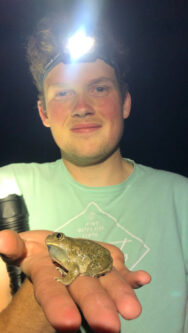U of L student researchers studying elusive toads
By Alejandra Pulido-Guzman - Lethbridge Herald on August 10, 2022.
 Submitted photo
Dustin Snider, a fourth-year ULethbridge student, holds a Plains Spadefoot Toad.
Submitted photo
Dustin Snider, a fourth-year ULethbridge student, holds a Plains Spadefoot Toad.LETHBRIDGE HERALDapulido@lethbridgeherald.com
The University of Lethbridge is conducting a summer research across Alberta on some elusive indicators of ecosystem health, the Plains Spadefoot Toad.
Because the Plains Spadefoot Toad spends most its time underground, many local residents may have never seen one, even though their range includes southern Alberta.
Summer students working in Dr. Julie Lee-Yaw’s biology lab at the University of Lethbridge are very keen about amphibians to the point where they are spending their free time looking out for the elusive toads.
“With every rain for the past three years, I would be out driving around the outskirts of town trying to find these toads,” says Lee-Yaw in a release.
The Plains Spadefoot Toad have been spotted as far north as Wainwright and as far west as Pincher Creek. While they may pop up from time to time to find food, they only emerge in large numbers to breed and only in certain weather conditions.
“The thing that’s very interesting about them is that they’re very secretive and cryptic. They will spend vast amounts of time underground, and they only come out when the conditions are just right and that means lots of rain and temperatures of 10 degrees or higher,” added Lee-Yaw.
Dustin Snider, a fourth-year student in Lee-Yaw’s lab, had seen a Plains Spadefoot in Cottonwood Park and was determined to find the breeding site of the population in the area.
Along with others in the lab, he combed the park paths at night in the middle of June and one night heard them calling in the distance.
“It was a real win for us to see this toad that’s at the northern edge of its range and that’s very rarely seen until it comes out in these really unique conditions,” said in a release Arianna Kuhn, a post-doctoral fellow in Lee-Yaw’s lab.
According to the release, in Alberta, the Plains Spadefoot Toad is listed as a species at risk of declining and is a high priority candidate for a status with the Committee on the Status of Endangered Wildlife in Canada (COSEWIC).Â
“COSEWIC has stated that 77 per cent of spadefoot toad habitat has been lost through the 20th century, mainly due to agriculture,” said Snider in the release.
He said the breeding site they located is very close to current residential areas and in a prime location for residential expansion. It could be bulldozed over within the next few years. With dwindling habitat for breeding, it’s important we protect the remaining sites.
When environmental impact assessments are completed for development projects, sensitive species like the Plains Spadefoot, which won’t be visible if the conditions haven’t been right, will be missed completely.
Other amphibians being studied by Lee-Yaw’s group include the long-toed salamander and the Western Toad.
“The biodiversity of Lethbridge and Alberta more generally is impressive. Taking a break from our regular project work just to appreciate this diversity is important to the lab and we encourage others to check out what’s right here in their backyard,” said Lee-Yaw in a release.
As a field technician in Lee-Yaw’s lab, Snider is working with Kaegan Finn, a graduate student, looking for new long-toed salamanders in under surveyed parts of the province.
Other students in the lab include Chinook Summer Research student Brianna Constable, who recently completed her second year in the biology department’s Research Internship Concentration (RIC) and who is studying colour pattern variation in these salamanders across seven states and provinces.Â
Daemon Wisniewski, who’s just completed his first year in the RIC program, has also been working in the lab and with collaborators at Yale University, preparing wood frog samples for genetic analyses and helping keep the lab’s large amphibian tissue collection organized. He recently tried his hand at night-time amphibian surveys and spotted the lab’s first tiger salamander of the season.
Follow @APulidoHerald on Twitter
21-20


